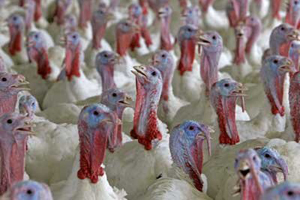Turkey farmers cope with high feed prices

Record-high feed costs this year have not been kind to many farmers who raise livestock, but turkey producers say healthy demand for their product has helped them weather the storm.
Bill Mattos, president of the California Poultry Federation, said the holidays are always “a good time for the turkey industry,” because of the whole-body birds that are sold about 40 percent of the year’s business and he expects the state will once again sell all of its turkeys this year.
Mattos noted that while U.S. poultry producers have had to reduce their production of chickens this year, turkey farmers matched supply to demand, and that has kept prices strong.
Despite the good business during the holidays, Mattos said the cost of feed “is still a very concerning issue” for turkey producers
“I’m looking at it as a positive year for sales,” he said. “It’s just that we have a lot of expenses, so it’s not going to be as profitable as previous years.”
As the largest contract producer for Foster Farms, Tim Nilsen, who runs three growing facilities in Sacramento County, said he’s insulated from the volatile feed market because the company supplies the feed, allowing him to focus on raising the birds.
He raises three flocks a year heavy toms that weigh as much as 50 pounds, virtually all of which go to further processing for turkey products such as deli meat and ground turkey or are sold as individual parts.
“For me, it’s actually been a decent year,” he said, noting that Foster Farms has kept his barns full and his operation has been growing at capacity. “But just because we’re maxed out, it doesn’t necessarily mean the industry is strong. We’re maxed out because of potential failures elsewhere.”
Fresno-based Zacky Farms, the second-largest turkey producer in the state, filed for Chapter 11 bankruptcy protection last month, blaming rising feed costs for its financial troubles.
Producers like Ken Mitchell from Sacramento County believe that they are at a disadvantage when it comes to feed because most of it has to come by rail from the Midwest, which adds to the costs. He said while growers make up some of that cost with better production because of the state’s mild weather and excellent growing conditions, the poultry sector “has struggled to find its footing in the last couple of years” due to uncertainty of the feed market.
Source: California Farm Bureau Federation












